Following the release of the Audi TT 2.0 TDI quattro, that is the question being asked to the Australian market. Audi boldly claims they are leading the way with the “first series production diesel sportscar”.
So, let’s look at this as objectively as possible then. The published 100km/h dash time is 7.5 seconds. Not too shabby, but not brilliant, either. In fact, that’s a few tenths slower than a Mk5 Golf GTI. In gear acceleration would be fun, though, courtesy of the 350Nm of torque at your right foot from just 1750rpm that is found deep inside the diesel donk. Maximum revs are just 5400rpm, however, so you would expect to be fiddling about with that manual box quite a bit. Peak power is just 125kW. So, we’re not quite cutting the sportscar mustard just yet.
Diesel engines are more refined than ever before, although they do still have a hint of tractor lurking in the engine bay. It’s not really a great sound for a TT is it. And its certainly no match for the sublime sounding 250kW five cylinder from the TT RS.
Fuel consumption is a luxury car tax shattering 5.3l/100km and CO2 emissions are a relatively meagre 139g/km. Not terribly sportscar like figures there, it has to be said. But in this instance, I guess that’s a good thing.
But, as an overall package, is the TT 2.0 TDI a good thing? Australians are embracing diesel powered cars more than ever before, but are they ready for a diesel TT? Sure, a TDI can be good fun in a Golf or an A3, surprising fun, in fact. But a TT? Does it really make sense?
So many questions. And I’m not sure Audi will find the answers they are looking for.
Tell us what you think in the comments section below.
The First TDI Sportscar Lands in Australia
- Audi leads the way with first series production diesel sportscar
- Extreme efficiency of just 5.3 litres/100km
- Audi now offers a range of 21 low consumption vehicles in Australia
Pure sportiness and compelling performance, combined with sensational efficiency is the best description of Audi’s newest TT model to arrive Down Under.
The all-new Audi TT Coupe 2.0 TDI quattro is the first series-production sports car in Australia to be powered by a diesel engine, further cementing Audi’s reputation for leading performance with TDI technology and clearly expressing the company’s desire to promote Progressive Performance – that is, performance combined with strong efficiency for guilt-free motoring.
The first premium brand in Australia to introduce a TDI engine into every major model line, Audi has now extended its diesel range into sports cars with a two-litre four-cylinder engine that delivers dynamic thrust of 125 kW and 350 Nm of torque.
On average, the TDI in the TT Coupe requires only 5.3 litres of fuel per 100 km – unbeatably low consumption in the sports car segment.
This extreme efficiency also means the new TT 2.0 TDI quattro is completely exempt from Luxury Car Tax, meaning the manufacturer’s recommended price, including GST, is just $70,900 (excl dealer delivery and Govt statutory charges).
Trendsetter: Audi sets the pace
Since TDI engines first appeared in 1989, Audi has been setting trends for the rest of the automotive industry. Today, these powerful, refined but highly efficient engines represent a modern, smart take on sportiness. The run of victories achieved by the Audi R10 TDI diesel racing car at the Le Mans 24 Hours and in the American Le Mans Series is impressive evidence of this leading technology.
Not only on the racetrack, the production versions of Audi’s diesel engines, are also noted for their dynamic performance, with the TT Coupe quattro 2.0 TDI sprinting from zero to 100 km/h in 7.5 seconds and achieving a top speed of 226 km/h.
The TT’s low weight is a key factor in this impressive performance, tipping the scales at just 1,370 kilograms and using the hybrid design pioneered by Audi. It’s forward structure is made from lightweight aluminium and the rear section is comprised of steel – to optimise weight distribution.
The power transmission for the TT Coupe 2.0 TDI quattro is also high-tech. An ultra-efficient, precise and easy-to-shift six-speed manual transmission delivers the engine’s torque to the all-wheel drive, itself featuring a hydraulic multi-plate clutch as its nerve centre. The clutch can redirect power as needed from the front to the rear wheels with lightning speed.
The chassis, with electromechanical power steering and elaborate four-link rear suspension, is a highly complex structure and guarantees a comfortable ride and surefooted handling.
At a glance – The Audi TT Coupe 2.0 TDI quattro
Engine
- Four-cylinder TDI with displacement of two litres, 125 kW output and 350 Nm torque
- Common rail fuel injection with piezo injectors for highly refined running
- 0 – 100 km/h in 7.5 seconds, top speed 226 km/h
- Average fuel consumption 5.3 litres/100 km
Power transmission
- Precise, highly effective six-speed manual transmission
- Quattro all-wheel drive with hydraulic multi-plate clutch
Chassis
- Four-link rear suspension for sporty handling and good comfort
- Power steering with highly efficient electric drive
Body
- Length 4,178 mm, drag coefficient 0.30
- Trunk capacity 290 to 700 litres thanks to folding seat backs
- Low weight thanks to innovative hybrid design, aluminium forward structure
The Long Version – Audi TT Coupe 2.0 TDI quattro
Audi is setting the standard once again, this time with the new Audi TT and its TDI engine – a model that blends purist sportiness, powerful performance and sensational efficiency.
The Audi TT Coupe 2.0 TDI quattro is the first series-production sports car in the world to use a diesel engine as its power source.
A fascinating combination, the two-litre four-cylinder engine delivers dynamic thrust, with a power output of 125 kW and 350 Nm of torque.
It sprints from zero to 100 km/h in only 7.5 seconds and achieves a top speed of 226 km/h, all the while consuming just 5.3 litres of fuel on average over 100 km, representing CO2 emissions of only 139 grams/km.
The engine
The new four-cylinder TDI with its capacity of 1,968 cm3 signals the advent of a new generation of dynamic, ultra-efficient Audi diesel engines. It interprets the consistently impressive qualities of the TDI concept in a fundamentally new way. This latest two-litre power unit, featuring two camshafts, builds on the strengths of its predecessor, once the most-manufactured diesel engine in the world – high pulling power, impressive efficiency and refinement.
The new common rail injection system is run by one of the most advanced control units on the market, and features ultramodern piezo injectors. Its eight-hole injectors can achieve up to five separate injection processes per combustion cycle. This fine-tuned approach produces a gentle pressure increase in the combustion chambers, decisively reducing the noise level. The single-piston high-pressure pump develops a system pressure of 1,800 bar, allowing fuel to form a fine dispersion, enabling precise, highly efficient combustion.
The turbocharger, too, belongs to a new generation. For a swift torque buildup it operates with adjustable vanes, and a special damper reduces its vibration. The engine’s intake manifold houses swirl flaps that generate a tumbling action in the inflowing air while electric motors regulate the flaps’ position so that this tumble is always adapted perfectly to the load and engine speed. The geometry of the engine’s pistons has been optimised, and the acoustics of the camshaft drive belt overhauled. Two balancing shafts reduce the second-degree inertial forces produced by the crankshaft drive.
High exhaust gas recirculation: low nitrogen oxide emissions
The cumulative result of this progress is a high maximum engine speed of 5,400 rpm and, most importantly, a significant improvement in thermodynamics in the combustion chambers. What this means is that the engine can run almost entirely on re-circulated exhaust gas that has been thoroughly cooled by the radiator. The cooler combustion process involving less oxygen drastically reduces engine emissions of nitrogen oxide.
The 2.0 TDI in the Audi TT, with a compression ratio of 16.5:1, delivers 125 kW at 4,200 rpm. It puts a hefty 350 Nm onto the crankshaft at engine speeds ranging from 1,750 to 2,500 rpm – where power really makes a difference to driving.
The four-cylinder power unit runs with little vibration and responds quickly to the accelerator. Its superb pulling power is available from rock-bottom upwards. It gives the 2.0 TDI a very distinctive, very strong character – that of a beefy, clever sports engine.
The on-road performance reflects this character with the Audi TT Coupe 2.0 TDI quattro leaving the competition in its wake with equivalent petrol engines, sprinting from zero to 100 km/h in just 7.5 seconds and not looking back until it reaches 226 km/h.
The TT Coupe 2.0 TDI quattro’s average fuel consumption of just 5.3 litres per 100 km, and emissions of 139 grams of CO2/km also sets a benchmark that represents a veritable quantum leap in the sports car segment.
The operating range of over 1,100 km on a single tank of fuel expresses this superiority in a very tangible way, shrugging off advances from its petrol-engined competitors, when the figures that really count are closely scrutinised.
Its specific output is 63.5 kW per litre of engine capacity, and its specific torque is 177.8 Nm per litre. But the most impressive ratio is power to fuel consumption and CO2 emissions. At just 0.90 kW per gram/km, the TT 2.0 TDI quattro is truly in a league of its own when it comes to efficiency.
The drivetrain
In keeping with the theme of sporty performance, Audi has equipped its diesel-engine sports cars with highly effective manual six-speed gearbox with a short lever travel to allow the driver to shift quickly, easily and precisely. The housing for this transmission is made of lightweight, high-tech magnesium. Relatively long final transmission ratios bring the drivetrain into line with the character of the TDI engine.
In light of its immense torque of 350 Nm, Audi equips its new TT model with quattro all-wheel drive as standard, improving traction, slip-free acceleration, drivability, stability and straight-line running in all weather conditions.
The nerve centre of the quattro drive in the TT is an electronically-controlled, hydraulically-actuated multi-plate clutch located at the end of the propshaft at the vehicle’s rear end – a position that improves the weight distribution. It distributes the torque continuously between the front and rear wheels depending on the driving situation. Thanks to a new pressure reservoir, the clutch works twice as fast as before, within a matter of milliseconds.
The chassis
The front suspension – a classic McPherson layout – is pivoted on an aluminium subframe. A highly precise rack-and-pinion steering system with a direct steering ratio provides an intimate link between the driver and the road. Power steering with servo assist, which decreases as speed increases, is generated by an electromechanical drive far more efficient than a hydraulic pump.
The coil springs and shock absorbers in the four-link rear axle are situated in separate areas. The control arms, too, are carefully configured. The trailing links, which absorb the propulsive and braking forces, have a relatively soft characteristic to promote ride comfort. The connections to the three transverse links per wheel, on the other hand, are rigid in order to direct transverse forces into the body with precision.
The large disk brakes with pads that support high coefficients of friction measure 312 mm at the front and 286 mm at the rear, and the front disks are ventilated. The ESP electronic stabilisation program is optimised for dynamic driving. A brief press of a button at lower speeds is all it takes to increase wheel slip, while a longer press of the button takes the TT driver into a second, sporty operating plane in which the ESP permits controlled sideslip angles. The brakes intervene later than normal and engine manipulation is suppressed.
Audi magnetic ride, a high-tech shock-absorber system available as an option, is an adaptive system that resolves the traditional conflict of interests between comfort and handling. A magneto-rheological fluid circulating in the shock absorbers changes its flow properties within milliseconds when a voltage is applied and this, in turn, alters the damping characteristic. The driver can choose between “Normal” and “Sport” programs by flipping a switch.
The body and interior
The intelligent lightweight design of the Audi TT 2.0 TDI quattro is a key factor in its sporty performance. The 2+2-seater Coupe tips the scales at only 1,370 kilograms. The low weight is the result of an innovative hybrid-design body developed by Audi. The forward structure is made of light aluminium components assembled using the space frame principle. Steel is used for the rear structure.
This solution guarantees that the frame is as rigid as possible and optimises load distribution between the axles. The bodyshell of the Coupe weighs 206 kilograms.
The design
The TT’s emotional design, all the way along its 4,178 mm body, is muscular and dynamic. The nose end is dominated by the large single-frame grille, and there is an automatically extending spoiler integrated at the rear. Subtle quattro badges identify it as a fundamentally all-wheel-drive vehicle. With a drag coefficient of 0.30, Audi demonstrates how good design can produce a low drag coefficient, translating into a higher top speed and better fuel efficiency.
The flowing dynamic style is echoed in the car’s interior. The driving area boasts clear-cut instruments that make reference to the classic circle motif, as do the air vents and rotary controls for the automatic air conditioning. The sports steering wheel with the flat-bottomed rim rests snugly in the hands. Perfect ergonomics and uncompromisingly high standards of build quality are always present in any Audi.
The height-adjustable sport seats are deep-set, providing a sporty seated position and firm lateral support. The backs of both rear seats fold down in the TT Coupe, making the trunk space grow from 290 to 700 cubic litres
TDI engines in motor racing
Since first appearing in 1989, Audi’s TDI engines have been setting trends for the rest of the automotive industry to follow. With their power, refinement and efficiency, they have come to represent a modern, smart interpretation of sportiness. The run of victories celebrated by the Audi R10 TDI diesel race car at the Le Mans 24 Hours and in the American Le Mans Series is impressive evidence of the tremendous potential of this technology.
The Audi R10 TDI has been blazing a trail since early 2006 – with its twelve-cylinder diesel engine it has entered an entirely new dimension. The 5.5 litre TDI is a race engine of superior pedigree. Its torque far surpasses that of any petrol engine, developing more than 1,100 Nm.
At nominal engine speed it delivers over 650 horsepower, producing a top speed of around 330 kilometres per hour.
The only minor problem encountered right at the start was due to the specific nature of the twelve-cylinder TDI – its very quiet running. The drivers of the open-top prototype – including multiple Le Mans winners such as the Dane Tom Kristensen and the German Frank Biela – had to get used to this fundamentally different attribute. Whereas they had previously been able to rely on the engine’s sound as a guide to its performance, above a given speed it was now no longer audible.
They soon adapted to the new situation, and the mighty diesel engine has since been demonstrating its strengths with resounding success. Among its virtues is fuel efficiency.
Compared with its predecessor, the already very efficient R8 with gasoline direct injection, the Le Mans version of the R10 TDI was markedly more economical. Furthermore the Le Mans circuit, with its long straights and scope for 75 percent use of full throttle, does not provide a true reflection of its strengths.
Fewer stops for refueling mean faster times – so high efficiency was the key to two successive victories in the tradition-steeped French endurance race. In 2006 Frank Biela, Emanuele Pirro (Italy) and Marco Werner (Germany) emerged as clear winners, completing 380 laps equivalent to 5,187 km at an average speed of 215.409 km/h . The same team of drivers again won in 2007, even though the organisers had capped the tank capacity of the R10 TDI. In difficult weather conditions Biela/Pirro/Werner clocked up 369 laps at an average speed of 209.152 km/h.
Downloads
- Audi TT 2.0 TDI quattro tech specs (28kb PDF)
- Audi TT Coupe brochure – May 2009 (184kb PDF)
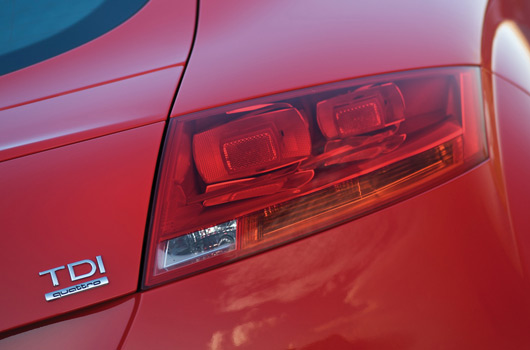
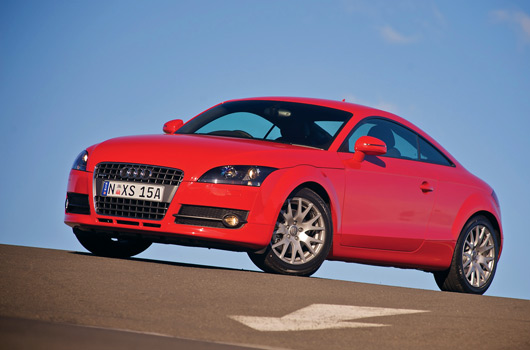
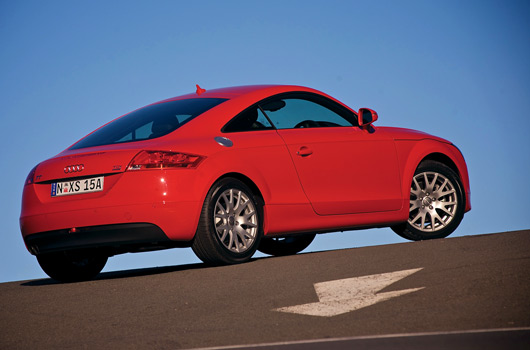
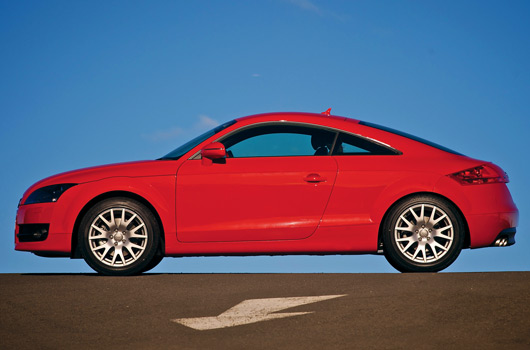
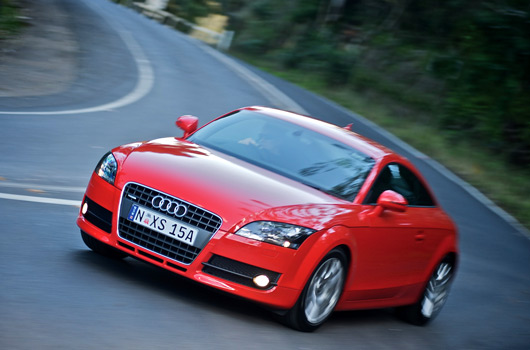
8 replies on “Would you like to buy a diesel TT?”
If I was in the market for a 2.0 TFSI model, I would certainly consider this instead.
I wouldn’t. It’s fun while you drive it, but then you get back into a petrol engined car and realise how much you have missed being able to rev the engine past 4000rpm.
Yep, I tend to agree.
Err… no.
The sound is so industrial!
As much as I love diesel, I own a TDI Golf GT, I wouldn’t do it in a TT.
It’s just not right.
Imagine if you went karting and they were all diesel? haha!
but think about all the money you’d save on fuel!
mmm, I’m in two minds with this. On one hand I love TDIs, and have thought about how a Mk1 TT would go with the old TDI as long ago as 2000. But having driven a Mk1 TT 225 and a, US spec, MkIV Jetta TDI I have to say I’d prefer the petrol in a TT.
Why would you want to buy a TT TDI I ask. Three years ago i agonised over 2 litre TDI Golf or GTI! I made the wrong decision and bought a DSG TDI and to be fair its a nice car! That’s it just nice not great. I can never get used to the diesel engine sound or the lack of top end performance. I am so excited about my new MK 6
GTI arriving Sept/Oct. If you are buying a TT TDI for the fuel saving its not a strong enough reason.